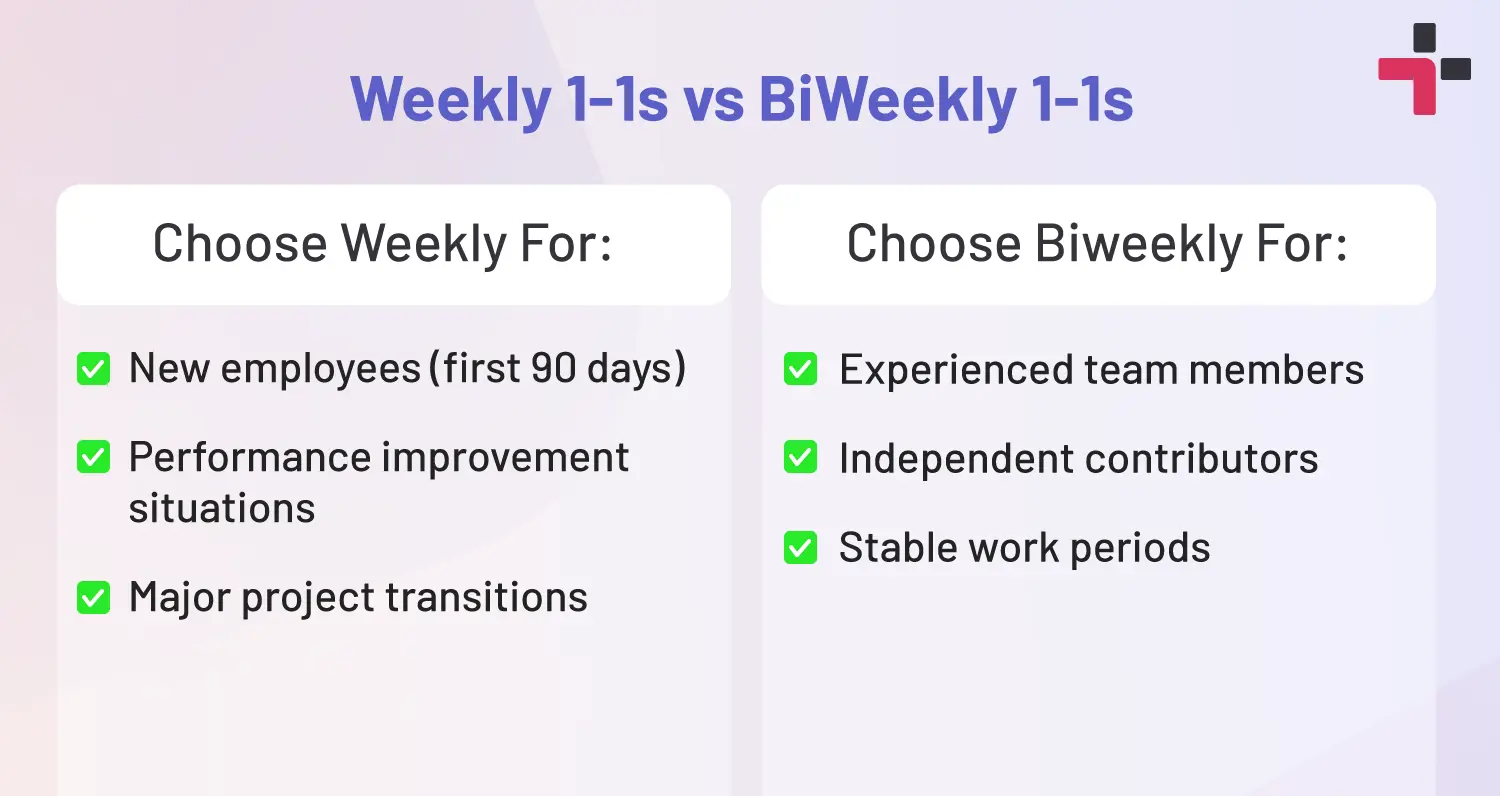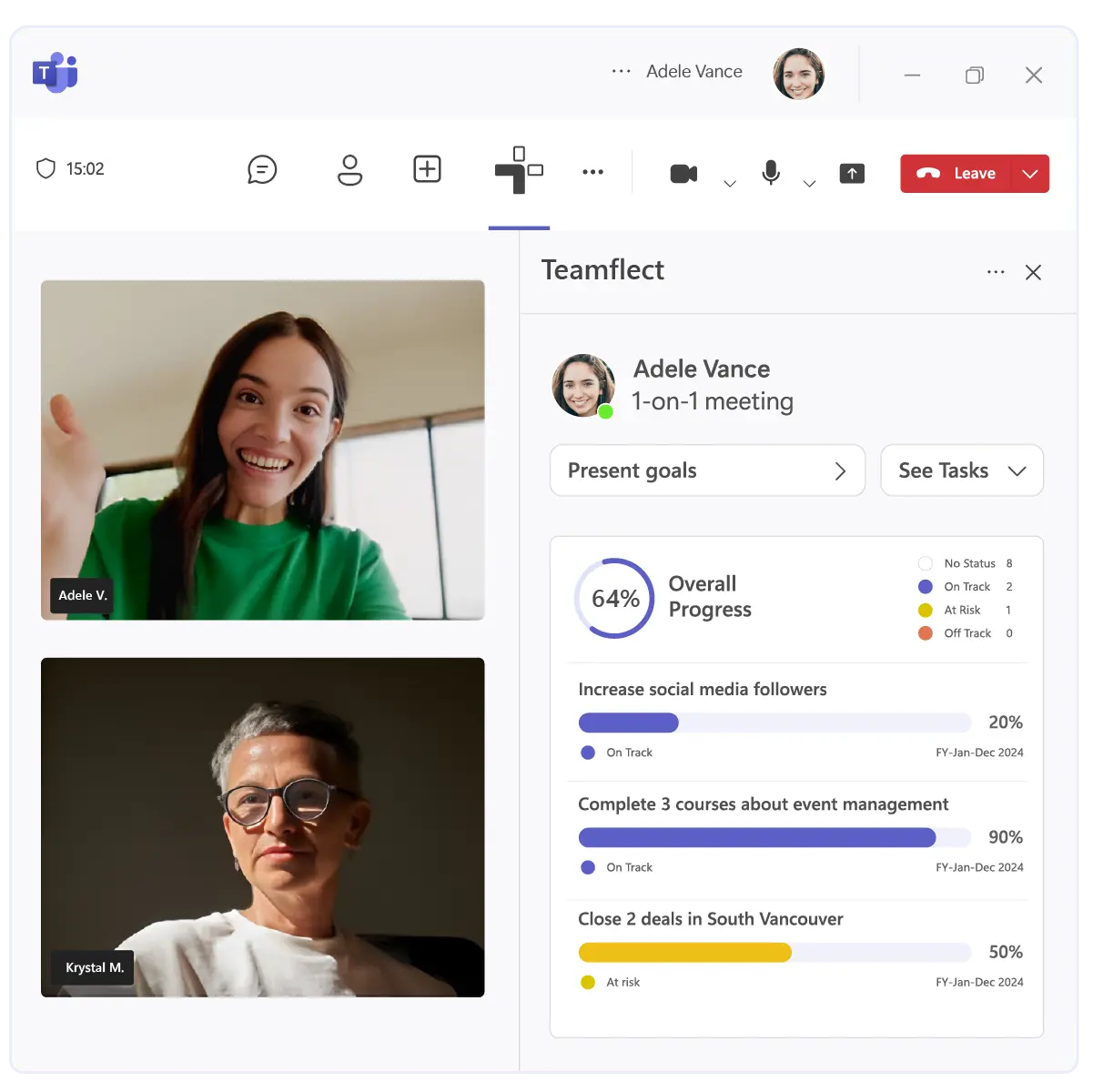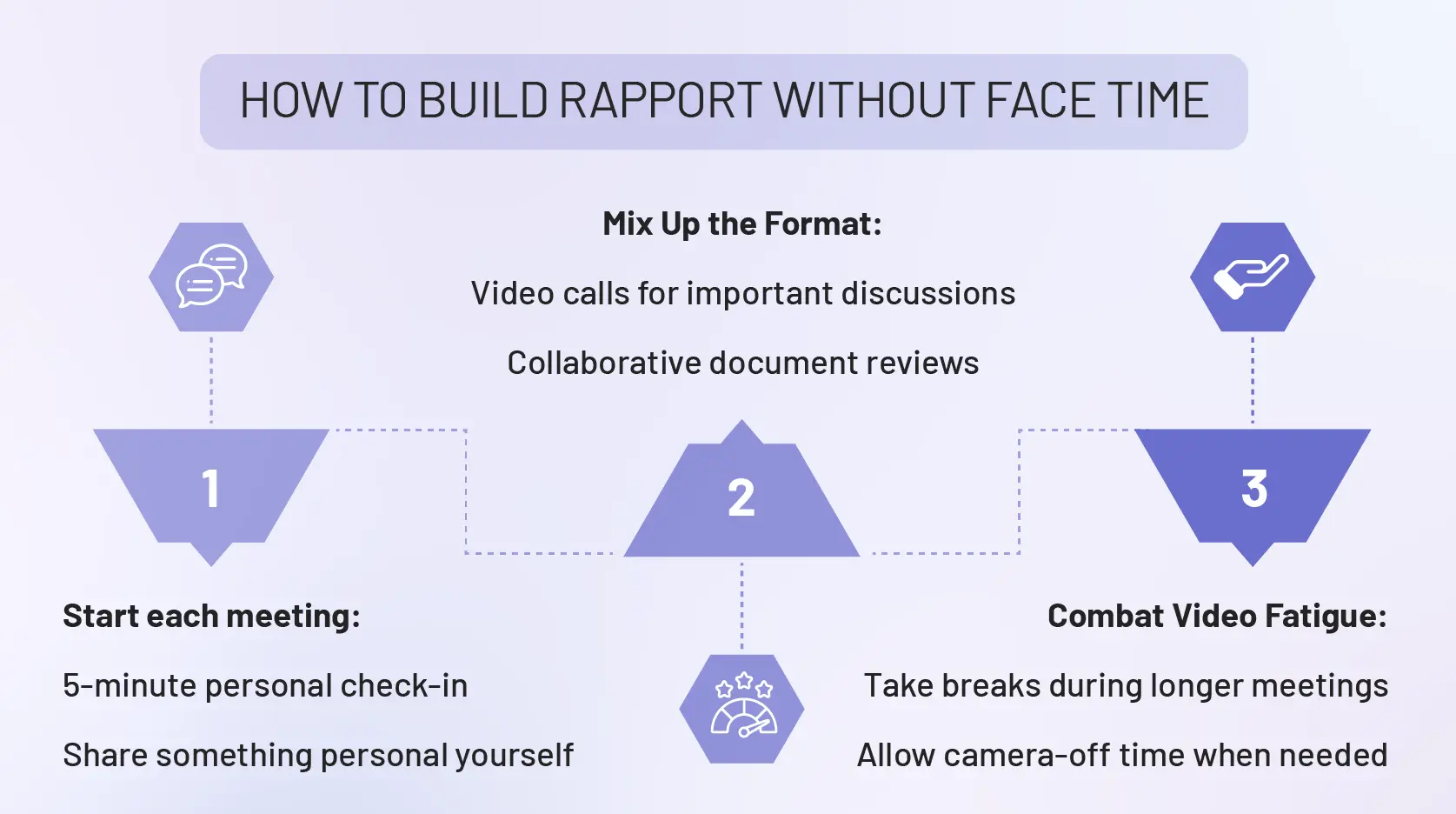Get the Ebook
.svg)
The shift to remote and hybrid work has made these individual touchpoints even more critical. Without casual hallway conversations, structured one-on-ones have become your primary opportunity to build trust, provide support, and drive employee growth.
One-on-one meetings are the most powerful tool for building strong manager-employee relationships. When done right, they boost engagement by 300% and increase team productivity by 18%(Source: Gallup).
This guide shows you exactly how to run effective one-on-one meetings that your team members will actually value, focusing on development over surveillance, outcomes over activity, and relationship-building over reporting.
The shift to remote and hybrid work has made intentional communication more critical than ever. Without casual hallway conversations and impromptu desk visits, structured one-on-one meetings have become the primary vehicle for building meaningful manager-employee relationships.
Another Gallup Study across some leading organizations consistently shows that regular one-on-one meetings dramatically improve workplace outcomes. These key statistics from the study that we are choosing to highlight here show just how important regular and effective 1-1 meetings can be in driving productivity and boosting engagement.
Key Stats:
Many managers confuse one-on-one meetings with scaled-down team meetings, but they serve completely different purposes. Understanding this distinction is crucial for making your individual meetings effective.
Team Meetings:
One-on-One Meetings:

Finding the right meeting cadence and duration for your one-on-one meetings depends on several factors, including your team member's experience level, current challenges, and work environment. The key is establishing a rhythm that works for both parties and sticking to it consistently.
The frequency of your meetings should match your team member's current needs and situation. Consider their experience level, the complexity of their role, and any ongoing challenges they're facing.
Choose Weekly For:
Choose Biweekly For:
The length of your one-on-one meetings should allow for meaningful conversation without becoming a burden on either person's schedule. Most effective meetings fall within a specific range that balances depth with efficiency.
Rule: Better to have consistent 30-minute meetings than sporadic 60-minute ones.

To help you run the most effective one-on-one meetings with your direct reports or members of your team, we created a wide variety of meeting agenda templates you can download for free.
These strategies transform ordinary check-ins into powerful development conversations. Each tip addresses a specific challenge that managers commonly face in their one-on-one meetings.
The most effective one-on-one meetings are employee-led, not manager-driven. When you let your team member set the agenda and lead the discussion, they're more likely to bring up what's truly important to them.
The quality of your questions determines the depth of your conversations. Open-ended questions encourage reflection and reveal insights that yes/no questions simply can't uncover.
Instead of: "How's the project?" Ask: "What's exciting you about this project, and what's keeping you up at night?"
Better Questions:
Without clear action items and follow-through, even the best conversations lose their impact. Documentation creates accountability and shows that you take these meetings seriously.

Using one-on-one meeting software can streamline your process and provide valuable insights over time. While not essential, the right tool can help you maintain consistency and track progress more effectively. While there are some great meeting tools out there, the best software for one-on-one or team meetings for organizations in the Microsoft 365 ecosystem is Teamflect.
Teamflect is a one-on-one meeting software built specifically for Microsoft Teams, that integrates not only with your Microsoft Teams account but also your entire Outlook calendar, syncing your meetings and agendas automatically.
It also let's you create comprehensive meeting agendas with recurring talking points, minutes, check-in forms, and so much more. As a complete performance management platform, Teamflect also integrates other key features into your meetings such as goal progress, employee recognition, feedback templates, and more.
Key Benefits:
People only share what's really on their minds when they feel safe to do so. Creating psychological safety requires vulnerability from you as the manager and consistent positive responses to difficult conversations.
While performance matters, one-on-one meetings should primarily focus on growth and future possibilities. This forward-looking approach energizes employees and demonstrates your investment in their success.
Development Questions:
Active listening is perhaps the most important skill for effective one-on-one meetings. Your job is to understand, not to be understood. This requires discipline and genuine curiosity about your team member's perspective.
The 70/30 Rule:
Small problems become big problems when left unaddressed. One-on-one meetings provide the perfect opportunity to give timely feedback and course-correct before issues escalate.
Recognition in one-on-one meetings feels more personal and meaningful than public praise. Taking time to acknowledge achievements, both big and small, reinforces positive behaviors and builds motivation.
Your presence, or lack thereof, sends a powerful message about the value you place on the relationship. Being fully present requires intentional choices about how you show up to these conversations.
How to Show Presence:

Remote work has changed the mechanics of one-on-one meetings, but the core principles remain the same. The challenge lies in adapting relationship-building techniques that were designed for in-person interactions to virtual environments.
Building personal connections through a screen requires more intentionality than in-person interactions. You need to work harder to create moments of human connection and combat the natural barriers that technology creates.
Start Each Meeting:
Mix Up the Format:
Combat Video Fatigue:
Having the right questions ready can transform an awkward silence into a meaningful conversation. These conversation starters have been tested in thousands of one-on-one meetings and consistently generate valuable discussions.
Your role as a manager is to create space for your team member to share what's really on their mind. These questions are designed to open doors and invite deeper conversation.
Opening Questions:
Development Questions:
Support Questions:
Feedback Questions:
As an employee, one-on-one meetings are your opportunity to get the support, resources, and development you need. Come prepared with specific topics and be ready to drive the conversation toward what matters most to you.
Come Prepared to Discuss:
Your Development:
Your Challenges:
Your Feedback:
Even well-intentioned managers can fall into traps that undermine the effectiveness of their one-on-one meetings. Avoiding these common mistakes will dramatically improve the quality of your conversations.
If your one-on-one feels like a verbal project management report, you're missing the opportunity for deeper connection and development. Status updates should happen through other channels, freeing up your precious one-on-one time for more meaningful conversations.
Don't Ask:
Instead Ask:
Canceling one-on-one meetings sends a clear message about priorities, and it's rarely the message you intend to send. When urgent matters arise, your response shows how much you value the relationship.
When You Must Reschedule:
Example Message: "I need to reschedule our 1-on-1 due to a client emergency. Are you available tomorrow at 2 PM or Thursday at 10 AM instead?"
One-on-one meetings and performance reviews serve different purposes and should feel different to your team member. Confusing the two can create anxiety and reduce the psychological safety that makes one-on-ones effective.
Performance Reviews Are:
One-on-Ones Are:
These frequently asked questions address the most common concerns and misconceptions about one-on-one meetings. Understanding these fundamentals will help you implement more effective practices.
A one-on-one meeting is fundamentally different from other workplace conversations. It's a dedicated time for building the manager-employee relationship and supporting individual growth.
A one-on-one meeting is a private, recurring conversation between a manager and employee focused on:
Duration: 30-60 minutes Frequency: Weekly or biweekly Focus: Employee-driven development conversations
The frequency of your one-on-one meetings should match your team member's current needs and situation. Different circumstances call for different approaches, but consistency is more important than frequency.
Weekly: New employees, performance improvement, major transitions
Biweekly: Experienced team members, stable periods
Monthly: Senior individual contributors (minimum frequency)
Best Practice: Consistency matters more than frequency. Choose a schedule you can maintain long-term.
The topics you discuss in one-on-one meetings should focus on your team member's growth, challenges, and success. This isn't the time for routine project updates or information that could be shared more efficiently through other channels.
Always Discuss:
Never Discuss:
The duration of your one-on-one meetings should allow for meaningful conversation without overwhelming either person's schedule. Most effective meetings fall within a specific range that balances depth with practical constraints.
30 Minutes: Standard check-ins, quick problem-solving 45 Minutes: Development discussions, feedback sessions 60 Minutes: Career planning, complex challenges
Tip: Start with 30 minutes and extend as needed. Quality conversation matters more than duration.
The best agenda provides structure while remaining flexible enough to address what matters most to your team member. This simple framework ensures you cover essential areas while maintaining a natural conversation flow.
Simple 5-Part Agenda:
Pro Tip: Use a shared document so both parties can add topics beforehand.
Remote one-on-one meetings require more intentional relationship building than in-person conversations. You need to work harder to create personal connection and combat the natural barriers that technology creates.
Key Strategies:
Same Principles Apply:
Understanding what to keep private and what to document is crucial for maintaining trust while meeting your organizational responsibilities. The key is being transparent with your team member about what gets shared and why.
Keep Private:
Document and Share:
Best Practice: Be transparent with employees about what gets documented and shared.
Getting started with effective one-on-one meetings doesn't have to be complicated. This quick start guide provides everything you need to run your first successful meeting and establish a strong foundation for ongoing conversations.
Before the Meeting:
During the Meeting:
After the Meeting:
Remember: Great 1-on-1s are built through consistency, genuine care, and focusing on your employee's growth and success.
An all-in-one performance management tool for Microsoft Teams
